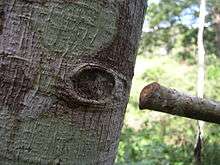Cladoptosis

Cladoptosis (Greek: clados - a branch, ptosis - falling; it is sometimes pronounced with the p silent) refers to the phenomenon in botany of the regular shedding of branches.[1] It is the counterpart for branches of the familiar process of regular leaf shedding by deciduous trees. As in leaf shedding, an abscission layer forms and the branch is shed cleanly.
Functions of cladoptosis
Cladoptosis is thought to have three possible functions, self-pruning (i.e. programmed plant senescence), drought response (characteristic of xerophytes) and liana defence. Self-pruning refers to the shedding of branches that are shaded or diseased and so potentially a drain on the resources of the tree. Drought response is similar to the leaf-fall response of drought-deciduous trees; however, leafy shoots are shed in place of leaves. Western red cedar (Thuja plicata) provides an example, as do other members of the family Cupressaceae. In tropical forests infestation of tree canopies by woody climbers or lianas can be a serious problem. Cladoptosis, to give a clean bole with no support for climbing plants, may be an adaptation against lianas, as in the case of Castilla.
See also
References
- ↑ Jim Hole (2005). "Cladoptosis". Retrieved 2007-01-14.
Further reading
- K. V. Bhat; T. Surendran; K. Swarupanandan (1986). "Anatomy of Branch Abscission in Lagerstroemia microcarpa Wight". New Phytologist. 103 (1): 177–183. doi:10.1111/j.1469-8137.1986.tb00606.x.
- Lorenza M. Bellani; Alessandro Bottacci (2004). "Anatomical studies of branchlet abscission related to crown modification in Quercus cerris L.". Trees. 10 (1): 20–23.
